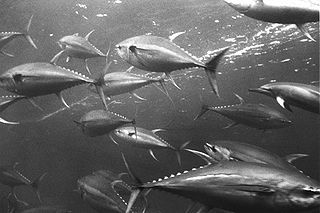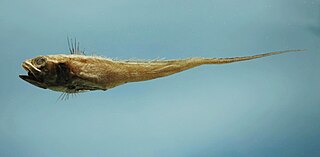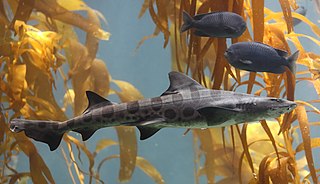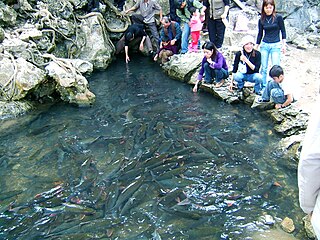
The Percidae are a family of ray-finned fish, part of the order Perciformes, which are found in fresh and brackish waters of the Northern Hemisphere. The majority are Nearctic, but there are also Palearctic species. The family contains more than 200 species in 11 genera. The perches and their relatives are in this family; well-known species include the walleye, sauger, ruffe, and three species of perch. However, small fish known as darters are also a part of this family.

The mackerel, tuna, and bonito family, Scombridae, includes many of the most important and familiar food fishes. The family consists of 51 species in 15 genera and two subfamilies. All species are in the subfamily Scombrinae, except the butterfly kingfish, which is the sole member of subfamily Gasterochismatinae.

Characidae, the characids or characins, is a family of freshwater subtropical and tropical fish belonging to the order Characiformes. The name "characins" is a historical one, but scientists today tend to prefer "characids" to reflect their status as a, by and large, monophyletic group. To arrive there, this family has undergone much systematic and taxonomic change. Among those fishes remaining in the Characidae currently are the tetras, comprising the very similar genera Hemigrammus and Hyphessobrycon, as well as a few related forms, such as the cave and neon tetras. Fish of this family are important as food in several regions, and also constitute a large percentage of captive freshwater aquarium fish species.

Grenadiers or rattails are generally large, brown to black gadiform marine fish of the subfamily Macrourinae, the largest subfamily of the family Macrouridae. Found at great depths from the Arctic to Antarctic, members of this subfamily are amongst the most abundant of the deep-sea fish.

Macrouridae is a family of deep sea fish, a diverse and ecologically important group, which are part of the order of cod-like fish, the Gadiformes. The species in the Macrouridae are characterised by their large heads which normally have a single barbel on the chin, projecting snouts, and slender bodies that taper to whip-like tails, without an obvious caudal fin but what there is of the caudal fin is often confluent with the posterior dorsal and anal fins. There are normally two dorsal fins, the anterior dorsal fin is quite high, the posterior quite low but is longer and takes up a greater proportion of the fish's back. Species in the subfamily Macrouroidinae have a single dorsal fin. The long anal fin is almost as long as the posterior dorsal fin, and sometimes it is longer. The pelvic fin is inserted in the vicinity of the thorax and normally has 5–17 fin rays but these are absent in Macrouroides. The body is covered in small scales and if they have a photophore, it is usually on the midline of the abdomen just in front of the anus. The bioluminescence of these fish is produced by symbiotic bioluminescent bacteria. The structure of the skull has been used to show their placing in the Gadiformes, but they differ from the typical cods in that they possess one stout spine in the anterior dorsal fin.

Puntius is a genus of small freshwater fish in the family Cyprinidae native to South Asia and Mainland Southeast Asia, as well as Taiwan.

The Carangidae are a family of ray-finned fish that includes the jacks, pompanos, jack mackerels, runners, trevallies, and scads. It is the largest of the six families included within the order Carangiformes. Some authorities classify it as the only family within that order but molecular and anatomical studies indicate that there is a close relationship between this family and the five former Perciform families which make up the Carangiformes.

The Triakidae or houndsharks are a family of ground sharks, consisting of about 40 species in nine genera. In some classifications, the family is split into two subfamilies, with the genera Mustelus, Scylliogaleus and Triakis in the subfamily Triakinae, and the remainders in the subfamily Galeorhininae.

The Gobiiformes are an order of fish that includes the gobies and their relatives. The order, which was previously considered a suborder of Perciformes, is made up of about 2,211 species that are divided between seven families. Phylogenetic relationships of the Gobiiformes have been elucidated using molecular data. Gobiiforms are primarily small species that live in marine water, but roughly 10% of these species inhabit fresh water. This order is composed chiefly of benthic or burrowing species; like many other benthic fishes, most gobiiforms do not have a gas bladder or any other means of controlling their buoyancy in water, so they must spend most of their time on or near the bottom. Gobiiformes means "goby-like".

Acanthurus japonicus, the Japan surgeonfish, white-faced surgeonfish, gold rim tang, powder brown tang and white-nose surgeonfish, is a species of marine ray-finned fish belonging to the family Acanthuridae, the surgeonfishes, unicornfishes or tangs. This fish is found in the Western Pacific Ocean.

Barbinae are a subfamily of fish included in the family Cyprinidae. The taxonomy for this group has not been entirely worked out as some genera historically considered within it are still considered incertae sedis with respect to being a member of the family, and may be included here, while others may be moved to other subfamilies.

Spinibarbus hollandi is a species of cyprinid fish endemic to Taiwan. It grows to 60 cm (24 in) length.
The Menderes barbel is a species of ray-finned fish in the genus Luciobarbus from the Büyük Menderes River basin in Turkey.
Catalog of Fishes is a comprehensive on-line database and reference work on the scientific names of fish species and genera. It is global in its scope and is hosted by the California Academy of Sciences. It has been compiled and is continuously updated by the curator emeritus of the CAS fish collection, William N. Eschmeyer.
Amamiichthys is a monospecific genus of marine ray-finned fish belonging to the family Sparidae, the seabreams and porgies. Its only species is Amamiichthys matsubarai, the Japanese blue-spotted seabream or hosheirenko. This species is endemic to the Amami Islands of southern Japan.

Cyprinae is a subfamily of largely freshwater ray-finned fishes, one of ten subfamilies belonging to the family Cyprinidae. This family comprises the carps, minnows, barbs and related fishes.

Xenocyprinae, is a contentious subfamily of the family Cyprinidae, the carp and minnow family, originally from eastern Asia.

Spinibarbichthys denticulatus, the phoenix barb or Chinese phoenix barb, is an Asian species of cyprinid freshwater fish of the subfamily Spinibarbinae. This fish is found in China in the Yuanjiang and Pearl basins, freshwater systems of Hainan, and Yangzong and Fuxian Lakes, in Laos in the Mã basin, and in Vietnam in the Red, Gâm, Lô and Mã basins, and freshwater systems from Nghệ An to Quảng Trị province. It occurs in large to medium rivers, deep pools of streams, in lakes and reservoirs, and it has a quite broad temperature tolerance, between at least 9 and 30 °C (48–86 °F) depending on season. Overall the species is widespread, but some local populations have been reduced due to overfishing, habitat loss and pollution. It is an important food fish that sometimes is aquacultured, and also kept as a garden pond or aquarium fish. Large numbers of the species can be found in the Cẩm Lương stream in Cẩm Thủy, Vietnam, where it is considered sacred and the locals protect and feed it, and it is also a tourist attraction.

Acrossocheilinae is a subfamily of freshwater ray-finned fishes belonging to the family Cyprinidae, the carps, minnows and related fishes. It contains thrre genera which are found in Southeast Asia and China. This taxon was originally proposed as a tribe, the Acrossocheilini, by Yang et al in 2015 but with the reclassification of the former subfamilies of Cyprinidae sensu lato into familes the status of this taxon was changed to subfamily.

Spinibarbichthys is a genus of freshwater ray-finned fishes belonging to the family Cyprinidae, the family which includes the carps, barbs and related fishes. The fishes in this genus are found in China and Southeast Asia.
















